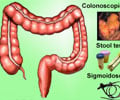
‘Treating metastatic colorectal cancer with the antiangiogenesis drugs such as bevacizumab (Avastin) significantly increases several components of the extracellular matrix and increases stiffness within liver metastases in both patients and mouse models.
’
Tweet it Now
Antiangiogenesis drugs were originally thought to improve cancer treatment by cutting off a tumor's blood supply. However, a hypothesis developed by Rakesh Jain, PhD, director of the Steele Lab and co-senior author of the current study that when given in judicious doses the drugs acted by normalizing the abnormal vasculature within a tumor, thus improving the delivery of chemotherapy drugs and response to radiation treatment - has been supported by many studies.Another factor that can impede drug delivery within tumors is a buildup of compressive forces that squeeze blood vessels shut. In addition to the pressure exerted by proliferating tumor cells, the extracellular matrix surrounding the tumor cells also contributes to these forces. Some recent studies have found that the hypoxia -- reduction in oxygen supply - induced by antiangiogenic therapy increases the expression in primary tumors of collagen, a major component of the extracellular matrix. The MGH team set out to investigate whether other matrix components -- specifically hyaluronic acid (HA) and sulfated glycosaminoglycans (sGAGs) - were affected by antiangiogenic therapy and, if they were, contributed to treatment resistance.
The research team first studied samples of liver metastases from patients with colorectal cancer and found the HA expression was increased within tumors, compared with unaffected liver tissue, and was even higher in metastases from patients who had received antiangiogenic therapy. In two mouse models of metastatic colorectal cancer, they found that antiangiogenic treatment increased compressive forces within liver metastases by stiffening tissues. Expression of both HA and sGAG was significantly higher after antiangiogenic treatment in the mouse models. In addition, antiangiogenic therapy appeared to cause an influx of suppressor immune cells that would reduce any immune response against the tumor.
Analysis of metastatic tissue from the mouse models revealed increased hypoxia and decrease density of microvessels after antiangiogenic therapy, followed by measurable increases in HA and sGAG. Inducing hypoxia in human liver stellate cells, the primary source of extracellular matrix, lead to a more than fourfold increase in the expression of HA. Adding an enzyme that targets HA to antiangiogenesis treatment in one of the mouse models caused a 74 percent reduction in HA levels and prolonged the animals' survival, compared with combination chemotherapy and antiangiogenesis alone.
"Although various mechanisms of resistance to antiangiogenesis therapy have been suggested, our study is the first to propose a role for the extracellular matrix and alterations in the mechanical properties of tumors," says Fukumura, who is an associate professor of Radiation Oncology at Harvard Medical School. "In addition to showing for the first time that antiangiogenesis therapy changes these properties within tumors, we also found that the hypoxia induced by extracellular matrix abnormalities attracts the immunosuppressive cells that help the tumor evade a systemic immune cell attack."
Advertisement
https://www.eurekalert.org/emb_releases/2016-10/mgh-mti101016.php
Advertisement









